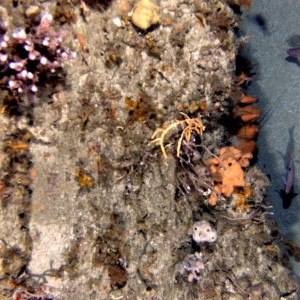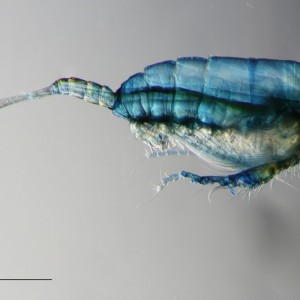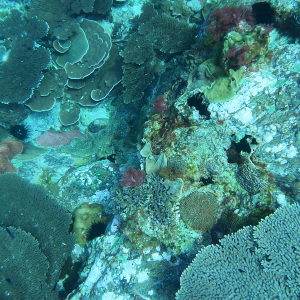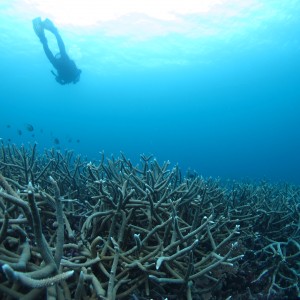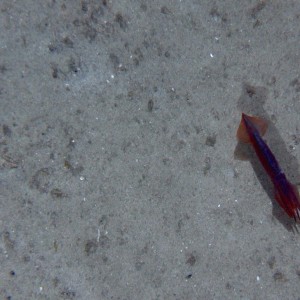AMPS Atlas
This is a compilation of all the images in this Atlas. To access images from particular marine parks, navigate to the image gallery on each marine park page.
Still image from AUV of a mid-shelf reef ledge at 60 metres depth in the Flinders Marine Park showing lobster antennae, butterfly perch (both associated with the ledge feature), sponges and the usual biogenic matrix.
 by IMOS, Institute of Marine and Antarctic Studies
by IMOS, Institute of Marine and Antarctic StudiesA dense school of barber perch, Caesioperca rasor, in Tasmania.
 by Rick Stuart-Smith
by Rick Stuart-SmithThis image was taken as part of a photo transect on the reef at Cartier Island.
A cock-eyed squid (Histioteuthis miranda) investigates a baited camera unit.
Evidence of the coldwater coral ecosystem recovered from the top of the largest of the Gloria Knolls, about 1200 metres underneath the ocean surface.
AUV image of reef habitat at Forty Acres Reef in the Solitary Islands Marine Park. Image shows an array of sponges, including cup sponge.
 by NERP
by NERPConceptual model of the Bremer ecosystem developed by marine experts as part of the NESP EP2 Project. Arrows represent interactions such as predator-prey relationships, behavioural responses, or human impacts, and are defined based on the best available scientific knowledge.

Reefs are incredibly important habitats. They provide a hard surface to which benthic organisms such as corals, kelps and sponges can attach, and once these organisms establish they provide complex 3D structures which can alter the environment by influencing factors such as water flow and the amount of light reaching the seafloor. A healthy reef ecosystem can contain thousands of different species of fish and invertebrates which are well adapted to these unique conditions, and use these habitats for shelter, foraging and recruitment grounds. This crab in the Kimberley Marine Park has made it's home inside a sponge, where it was found hiding with a host of juveniles.
Deposits of Tasmania's mineral emblem, Crocoite, on a seamount peak adjacent to the Huon Marine Park (1202 metres depth). This rare lead-chromate crystal is known only from terrestrial mines, prominently in western Tasmania.
 by CSIRO
by CSIROIn September 2016 the Hub facilitated the deployment of the IMOS AUV "Sirius" in the Freycinet Marine Park. The mission involved re-surveying a range of locations previously visited within the Marine Park to examine temporal patterns in the cover of benthic invertebrate fauna and benthic fishes. These included surveys on Joe's reef, an isolated granite bommie of 200 metres length, rising 20 metres above the seabed in 80 metres of water, and known to contain a significant cover of black corals.
 by Institute of Marine and Antarctic Studies, NESP Marine Biodiversity Hub
by Institute of Marine and Antarctic Studies, NESP Marine Biodiversity HubMonitoring sites were surveyed along permanent transect lines, photographed at 1 metre intervals
 by AIMS
by AIMSDiver swimming over coral reef
 by Aaron Chai, University of Queensland
by Aaron Chai, University of QueenslandAn Eastern Rock Lobster (Sagmariasus verreauxi) foraging on a deep reef within the Huon Marine Park. Note the white coloration on the lobster, a typical feature of lobsters on deep shelf reefs in Tasmanian coastal waters. It is only when lobsters forage in shallower water that they attain their typical red colouration, a result of the higher abundance of carotinoid pigments in the marco- and encrusting algal assemblages which upon consumption will accumulate in the lobster's exoskeleton. Lobsters are regularly seen in AUV imagery from the Huon Marine Park.
 by Institute of Marine and Antarctic Studies
by Institute of Marine and Antarctic StudiesField team members getting ready for departure aboard the ‘Big Dreams’. Left to right: John Totterdell, Bruce King, David Bond, Louis Masarei, Adam Jolly and Jem Turner.
Catch composition by salted weight of sea cucumbers on two foreign owned and crewed fishing vessels apprehended in the Coral Sea. Foreign fishing vessel 2 was believed to have had two separate fishing episodes thus the ‘recent’ and ‘older’ terminology.
Foreign fishing vessel with sea cucumber cargo and tug.
 by Parks Australia
by Parks AustraliaGiant basket sponge (Xestospongia testudinaria) on reef in Carpentaria Marine Park
 by Reef Life Survey
by Reef Life SurveyReef animals including gorgonians at Carpentaria Reef, Carpentaria Marine Park
 by Reef Life Survey
by Reef Life SurveyReef animals including gorgonians at Carpentaria Reef, Carpentaria Marine Park
 by Reef Life Survey
by Reef Life SurveyThis image of a Gould's squid (arrow squid/dart squid/Nototodarus gouldi) was taken by an Autonomous Underwater Vehicle (AUV) during a survey in the Freycinet Marine Park. Gould's squid are a schooling species that inhabit coastal and nearshore waters, preferring shallow reef, sand and seagrass habitats on the continental shelf. Gould's squid are typically light-brownish pink to brick red in colour, but like other cephalopods they can change the colour of their skin in the blink of an eye. This allows them to either mimic the colours of their surrounding environment and render themselves almost invisible to predators, or alternatively give themselves a colour or pattern that makes them stand out.
 by Institute of Marine and Antarctic Studies
by Institute of Marine and Antarctic Studies

